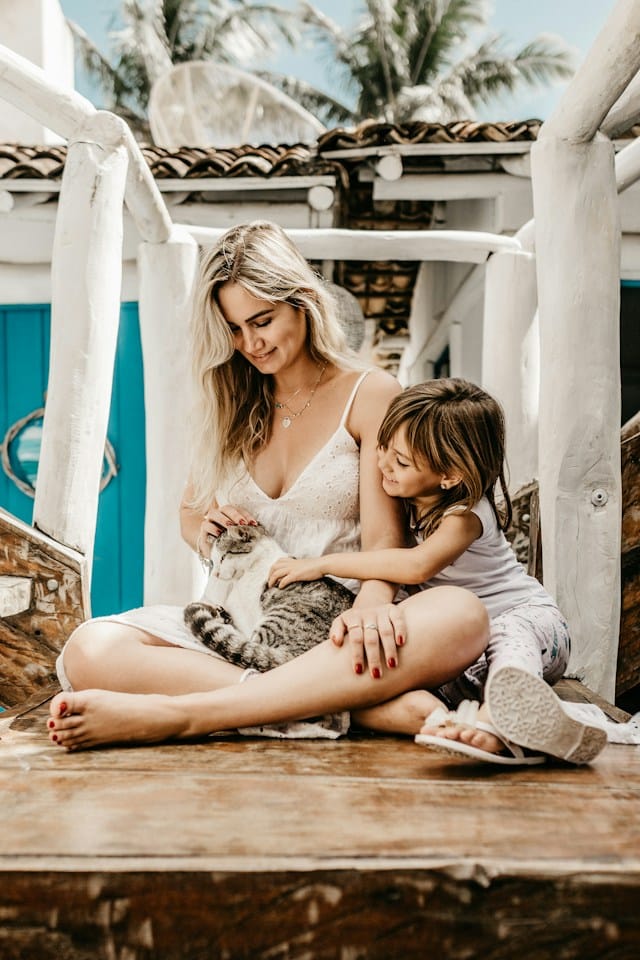There are few relationships in the world as pure and heartwarming as the one between a child and their pet. The affectionate play, mutual trust, and unspoken understanding foster a bond that lasts a lifetime. But when you are introducing a new baby into a household with a pet, the transition must be managed with utmost care, to ensure the safety and comfort of both the baby and the pet. So, let’s explore the best approach to facilitate this introduction and establish a harmonious relationship.
Understanding The Pet’s Perspective
Before we dive into the steps of introducing a baby to a pet, it’s vital to understand the situation from the pet’s perspective. They have been the center of attention and suddenly, they are expected to share their space with a new, somewhat noisy and unpredictable creature. This drastic change can induce stress and anxiety in the pet.
A lire également : What Are the Best Strategies for Pets Struggling with Seasonal Affective Disorder?
The key to a smooth transition lies in gradual preparation. Start making minor adjustments to the pet’s routine well before the baby’s arrival. For instance, if the pet is not accustomed to noisy environments, gradually acclimatize them to it. Play recordings of baby sounds at a low volume, slowly increasing it over time. This can help the pet adjust to the new sounds before the baby arrives.
If the pet is used to sleeping in your room, gradually move them to a new sleeping area. This will help avoid territorial issues once the baby is home. Similarly, if the baby’s room was previously accessible to the pet, start restricting access.
A voir aussi : How to Safely Manage Pets in Urban Areas with High Traffic?
Preparing The Pet for The Baby’s Arrival
The pet should be well-prepared for the baby’s arrival. This can be achieved by associating the baby with positive experiences for the pet.
Start by introducing the pet to baby-related items like baby lotion or powder. Let them sniff the items to familiarize themselves with the new smells. You can also get a doll and handle it like you would your baby – feed it, change its diapers, put it to sleep, etc. This will show the pet what to expect when the baby arrives. Reward the pet with treats and praise when they behave well around the baby’s items or the doll.
When the baby is born, before bringing him or her home, bring something with the baby’s scent, such as a blanket or a piece of clothing, and let the pet sniff it. This will serve as the pet’s first introduction to the baby.
The First Meeting
The actual introduction of the baby to the pet is a crucial step that should be handled with care. The environment should be calm and controlled.
Choose a quiet room and have one person hold the baby while another person controls the pet. Allow the pet to enter the room and sniff the baby from a safe distance, while talking to them in a calm and reassuring voice. The pet should not be forced to approach the baby if they are not ready.
It is very important to supervise all interactions between the baby and the pet. Never leave them alone together, no matter how well they seem to be getting along.
Building a Positive Relationship
After the initial introduction, continue to foster a positive relationship between the baby and the pet. Praise the pet for behaving well around the baby. If the pet seems anxious or stressed, provide them with a safe space where they can retreat.
As the baby grows and starts to interact with the pet, teach them to be gentle and respectful. Children should understand that pets are not toys and they should not be disturbed while eating or sleeping.
Common Mistakes to Avoid
It is equally important to know the common mistakes that people make when introducing a baby to a pet. Many times, people tend to neglect the pet once the baby arrives. This can make the pet feel left out and resentful.
Additionally, forcing interactions between the baby and the pet can also lead to problems. Allow the relationship to develop naturally. It may take some time for the pet to adjust to the new member of the family and that is perfectly okay.
Remember, patience and understanding are key to successfully introducing a baby to a household pet. It is a gradual process that requires constant supervision and guidance. But once done right, the bond that forms between a child and their pet can be an incredibly fulfilling experience.
Post-Introduction Adjustments
After the initial introduction, there will likely need to be many adjustments made to accommodate both a baby and a pet living under one roof. Recognizing the signs of stress in both the baby and the pet is crucial. Furthermore, ensuring they both have their own separate spaces, maintaining consistency in routines – for both the baby and the pet – and being mindful of the baby’s developmental stages as they grow are all necessary for this new cohabitation to work seamlessly.
If your pet seems to be displaying signs of stress, such as excessive licking, pacing, or changes in eating habits, it’s crucial to address these signs immediately. A stressed pet can lead to unpredictable behavior which could be dangerous for a baby. Seek advice from a professional, such as a vet or animal behaviorist, who can provide guidance on relieving your pet’s stress.
Consistency in routines is vital in keeping both the baby and pet feeling secure. Try to keep your pet’s feeding, walking, and play times the same, even after the baby arrives. This consistency can help reassure the pet that their status in the family has not changed.
As the baby grows and begins to crawl or walk, they will become more interactive with their surroundings. At this stage, it becomes vital to closely monitor the baby’s interactions with the pet, and vice versa. This can be a wonderful time for bonding, but it also increases the potential for misunderstandings.
Conclusion: Patience and Understanding
Introducing a baby to a household pet requires careful thought, planning, and patience. It can be a challenging process, but with the right approach, it can lead to a rewarding and fulfilling relationship between your child and their pet.
Remember, every pet and every child is different and their bonding process may take time. It is absolutely okay if the bond does not form immediately. What is essential is ensuring both the baby and the pet feel safe, loved, and comfortable in their shared environment.
Do not hesitate to seek professional advice if you notice any signs of stress or aggression in either the pet or the baby. And always remember, even in the most well-adjusted households, never leave a baby and a pet unsupervised together.
Understanding the needs and emotions of both your baby and pet is key to fostering a harmonious bond. With time, patience, and guidance, the bond that forms will be one that is incredibly fulfilling and enriches the lives of both child and pet. This preparation and effort will surely be rewarded with a beautiful and heartwarming bond that will last a lifetime.











